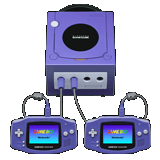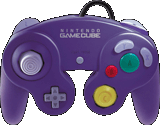The Gamecube launched in full
force Sunday, putting 700,000 units on the shelves (more than any other next-gen launch).
According to Nintendo’s own estimations, about $100 million worth of them were sold
the first day. For those of you who didn’t rush right out and buy one of
Nintendo’s funky little indigo or jet black boxes (those of you who still have the
bitter taste of the N64 lingering in your mouths, no doubt), we have the skinny for you
right here.
 Measuring a diminutive
6" x 4½" x 6", and weighing under 3 lbs., the Gamecube (GC) looks as if it
is just begging to be taken seriously, especially with that goofy handle sticking out of
its back. But take it seriously you should, because technically, it is a gaming
powerhouse. In terms of hardware, the GC sports a 485 MHz CPU, a 162 MHz
"Flipper" graphics processor, and 40 MB of total memory (24 MB of MoSys 1T-SRAM
and 16 MB of auxiliary RAM). All of these numbers fall just under the Xbox (the current
hardware champ) and just above the PS2. The GC’s strongest point as far as graphics
go is texture rendering—eight textures in one render pass, while the Xbox can do four
and the PS2 only one. The GC supports the full range of video connections: Composite,
S-Video, and Component. S-Video and Component connections require cables sold separately,
but if you had an S-Video cable for your N64, it is compatible with the GC. Unfortunately,
it does not support digital surround sound, though some games are compatible with Dolby
Pro Logic II.
Measuring a diminutive
6" x 4½" x 6", and weighing under 3 lbs., the Gamecube (GC) looks as if it
is just begging to be taken seriously, especially with that goofy handle sticking out of
its back. But take it seriously you should, because technically, it is a gaming
powerhouse. In terms of hardware, the GC sports a 485 MHz CPU, a 162 MHz
"Flipper" graphics processor, and 40 MB of total memory (24 MB of MoSys 1T-SRAM
and 16 MB of auxiliary RAM). All of these numbers fall just under the Xbox (the current
hardware champ) and just above the PS2. The GC’s strongest point as far as graphics
go is texture rendering—eight textures in one render pass, while the Xbox can do four
and the PS2 only one. The GC supports the full range of video connections: Composite,
S-Video, and Component. S-Video and Component connections require cables sold separately,
but if you had an S-Video cable for your N64, it is compatible with the GC. Unfortunately,
it does not support digital surround sound, though some games are compatible with Dolby
Pro Logic II.
Unlike the all-in-one approach of the Xbox and PS2, the GC was deliberately designed as
a games only system, foregoing DVD movie and CD playback. Nintendo has learned from past
failures and successes, however. Out are the days of cartridge games (thank God) and
frustrating game save features. In are 3" mini-DVDs and traditional memory cards. The
GC has two memory card slots and four controller ports. It also has two serial ports and a
high-speed port for later add-on devices like the 56K modem, broadband adapter, and hard
drive to be released later. The lack of DVD/CD playback, and a hard drive and internet
connectivity out of the box may make it seem like the GC is lacking in extra features. But
remember, at $199 it is $100 cheaper than the Xbox and PS2. Kind of makes you wonder why
you paid $299 for a PS2 (which, in addition to having only two controller ports, also
lacked a hard drive and internet connectivity at launch), doesn’t it? Plus, the GC
has the added ability to link with multiple Gameboy Advance systems via the controller
port and special link cables for added game features, such as hidden game menus in
multiplayer games.
 The controller configuration
is strikingly similar to the Xbox’s. The dual joysticks, D-pad, and button pad are in
pretty much the same place, only the GC’s controller is smaller, more comfortable,
and has fewer buttons. There are four buttons on the button pad, two dual-function
triggers, and a Z-button above the right trigger. The shoulder buttons are the only analog
buttons on the controller. They can be pulled back to a stopping point (function 1) and
then clicked (function 2). This allows for intuitive control set-ups, as in Rogue Leader,
where pulling back the right trigger gradually accelerates your spacecraft, and clicking
it gives you a turbo boost. The controller has a built-in rumble feature as well. Overall,
I have found the GC controller to be accessible and easy to use. It is small enough that
my seven year-old son can reach both shoulder buttons and both joysticks at the same time,
which he has trouble doing on the larger Xbox controller. There have been complaints that
the Z-button is hard to use where it is placed, but I have had no trouble with it.
However, the button pad configuration is a bit wonky. The A button is huge, which is fine,
but the B button is small and a little awkward. Also, I don’t think that the C
joystick is as comfortable as the directional stick, which has a much better design. And
the cords are short (6½ feet), so expect to buy extension cords.
The controller configuration
is strikingly similar to the Xbox’s. The dual joysticks, D-pad, and button pad are in
pretty much the same place, only the GC’s controller is smaller, more comfortable,
and has fewer buttons. There are four buttons on the button pad, two dual-function
triggers, and a Z-button above the right trigger. The shoulder buttons are the only analog
buttons on the controller. They can be pulled back to a stopping point (function 1) and
then clicked (function 2). This allows for intuitive control set-ups, as in Rogue Leader,
where pulling back the right trigger gradually accelerates your spacecraft, and clicking
it gives you a turbo boost. The controller has a built-in rumble feature as well. Overall,
I have found the GC controller to be accessible and easy to use. It is small enough that
my seven year-old son can reach both shoulder buttons and both joysticks at the same time,
which he has trouble doing on the larger Xbox controller. There have been complaints that
the Z-button is hard to use where it is placed, but I have had no trouble with it.
However, the button pad configuration is a bit wonky. The A button is huge, which is fine,
but the B button is small and a little awkward. Also, I don’t think that the C
joystick is as comfortable as the directional stick, which has a much better design. And
the cords are short (6½ feet), so expect to buy extension cords.
The GC’s system menu is not as sophisticated as that of the Xbox, but it certainly
is laid out better than the PS2’s. Graphically, the menu is represented as a 3D cube
(no surprise there) that rotates to one of four menus that allow you to set the calendar
and clock, configure the video and audio, and manage the memory cards.
I could talk hardware all day (quicker for you to just click here), but it don’t mean
a thing if it ain’t got the games. This is where, depending on your tastes, the GC
distinguishes itself a little. A quick look at the list of games set for release in the
upcoming year will tell you that the majority of third party titles are going to be
available on all three systems. This is great, because it takes some of the financial
pressure off of both the developer and the consumer. But when it comes to the short list
of exclusive games, the GC has the most distinctive list. Soon to be released are Super
Smash Bros. Melee and Pikmin, an intriguing strategy/critter-raising game. In development
are titles like Mario Sunshine, Legend of Zelda, Metroid Prime, Starfox Adventures, and
Perfect Dark Zero. The exclusive titles are not all Nintendo mainstays, however. Nor are
they all "kiddie games." Capcom recently announced that their extremely popular
survival horror series, Resident Evil, will be exclusive to the GC for at least 5 titles,
including two all new games. Admittedly, the GC’s launch line-up lacks anything that
can be called a "killer app." Star Wars Rogue Squadron II:
Rogue Leader, Luigi’s
Mansion, Wave
Race: Blue Storm, Super
Monkey Ball, and Tony Hawk’s Pro Skater 3 are all great games, but I think we
will have to at least wait until Pikmin, and possibly for Mario, Zelda, Metroid, or
Perfect Dark before we can start using that particular buzzword. For those of you who are
only interested in the right here, right now, the PS2 is the hands-down winner when it
comes to games.
With the GC, Nintendo has created a terrific game system, especially if you already
have a DVD and CD player. It is powerful enough to remain competitive in the years to
come. It is also developer-friendly, so the third party companies are definitely on board
this time around. At $199 it is both priced to own, and priced to modify, if you wish.
When the time comes, you will only be forced to spend around $300 dollars for a 4-player
system with hard drive and internet connectivity—the same as an Xbox. In comparison
you will have to spend around $435 or more for a PS2, a 4-player multitap, a modem, and a
hard drive. When it comes to games, the GC is by far the most kid-friendly system, though
that does not mean kids-only. It is also cute-hip in a tiny shelf stereo with dancing
lights kind of way. The general consensus here at GamesFirst! is that you can’t go
wrong with any of the three next-gen systems. I know that makes it tough on people looking
to purchase one system. Sorry, that’s just the way it is. But I would have to say
that for anyone planning on buying two systems, your best bet, in terms of variety of game
play, is to pick up a GC and either a PS2 or an Xbox. Of course, that last choice is the
subject of an on-going debate, and other articles (feel free to check out Shawn’s not
entirely impartial editorial, Xbox Vs. PS2
Redux here).
